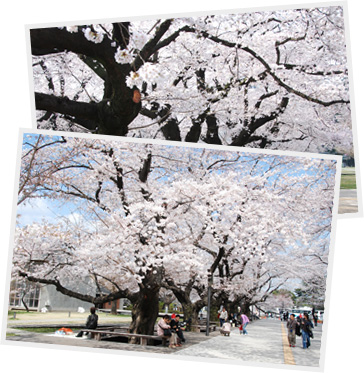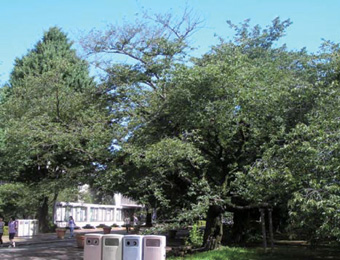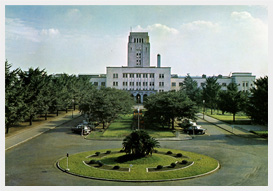As spring arrives, the cherry blossom trees leave an impression of Tokyo Tech's traditions and warmth on that year's graduates while bringing a sense of the Institute's history and an anticipation of campus life to incoming freshmen. These old trees were planted in rows along all the campus roads, with the rows in front of the Main Building the crowning glory. They have been beloved for many years by students, faculty members and administrative staff, as well as local residents and graduates. Cherry blossoms are said to not require pruning, and these trees have been allowed to grow naturally, with only branches that are damaged by the wind and snow and those that grow dangerously long being removed while maintaining the overall shape of the trees. Disease-carrying insects that could harm the trees are also typically exterminated.
As noted in an article written by alumni1, the history of Tokyo Tech's cherry blossom trees starts with the ones planted in front of the Main Building in 1950, those running along the side of the 70th Anniversary Auditorium to the student cafeteria, and those planted around the West Building 1 in 1953. The remainder of the trees was planted at various later dates. Graduates from each of these times expressed a strong collective will to plant the trees in commemoration of their graduation, despite the fact that the economic situation in those days was not as favorable as it is today. They are still looked up to with respect even today.
The majority of the cherry blossoms planted on the Institute's grounds are of the Yoshino (Somei Yoshino) species. In recent years they have begun showing signs of deteriorating vitality, especially the old ones planted in front of the Main Building, as can be seen in Photograph 1. It is said that the life span of a Yoshino cherry blossom tree is 60 years, and the 16 in front of the Main Building, consisting of two rows of eight, which have been an overwhelming attraction for people over the years, have already reached the age of 55 [today, 64]. They are fast approaching the end of their life spans.
Everyone who has come in contact with these trees, including the graduates who originally donated them, the Tokyo Tech community and others in the wider community, as well as the people charged with taking care of them, shares a common wish: that the trees live for a very long time. Activities and initiatives to protect cherry blossom trees are carried out at different levels throughout the country, and the question as to what initiatives Tokyo Tech should adopt has been raised.
As noted in a recent NHK broadcast2, the traditional method of prolonging the life of a cherry blossom tree is now in the process of being overturned after the evaluation of actual results. A new tradition is gradually taking root. This new method, a type of pruning called heading-back cut, claims that even cherry blossom trees should be boldly pruned to remove old branches so that new shoots can appear and grow into new branches. In other words, cutting back the trees is an appropriate method of maintenance. The famous cherry blossom trees in Hirosaki Park in Aomori prefecture have been pruned in accordance with this method since 1955 to allow healthy branches to grow, and they still charm visitors when they are in full bloom each year. Some of these trees are Yoshino cherry trees that are 123 years old.
The heading-back cut is one of the main types of cuts used in pruning and primarily carried out on fruit trees. Long branches are cut off to prevent the shape of the tree from becoming distorted. It is a pruning method carried out to promote the growth of healthy main branches. As the rows of fruit trees planted in orchards grow larger with age, they are forced to compete with neighboring trees. Furthermore, as a tree grows taller it has trouble conveying nutrients to the top of the tree, which leads to a deterioration in its vitality. A lack of sunlight reaching the innermost part of the tree can also result in outbreaks of disease-carrying insects, which can cause serious damage. With heavy pruning, the large branches are systematically cut back to allow new shoots to grow on newly appearing branches each year, which is a kind of heading-back cut. Heavy pruning maintains the shape of the tree and enables good-quality fruit to sprout from young and vital branches.
Having become aware of the various problems mentioned above that can damage Tokyo Tech's old trees, which are more than 50 years old, we decided to study the vitality of the trees to determine what we should do for them in the future. In other words, one of the options we had was to manage them naturally to maintain their beautiful hemispheric shapes and plant young trees to hand over to the next generation when the old trees die. (In actual fact, Somei Yoshino trees are cloned from the roots of the same species.) The other available option was to do as much as we could for the trees centered using the heavy pruning technique in order to extend their life spans. I wrote this article for the sake of obtaining the understanding of the Tokyo Tech community for our decision to prune the cherry blossom trees, as this will result in a drastically different shape in the future for the cherry blossom trees which is explained below. In other words, the heavy pruning method of tree maintenance includes several large problems that are mentioned below. We wonder how the cherry blossom trees feel about our decision. Is it possible that the soul of a cherry tree interacts with our love and care for it?
The main difference between the two methods is the end shape of the tree resulting from heavy pruning as shown in Table 1. First of all, the shape of the tree changes from a hemisphere to a more flattened shape, the height of the tree drops to half or two-thirds of its original height, and the structure changes into a sort of stepped structure, all of which greatly alters the appearance and impression of the tree. Although a different tree shape may be acceptable as long as its life-span is extended, it must also be understood that implementing first-aid maintenance such as this while keeping a close eye on the state of the tree is not always 100 percent successful. The risks that must be understood when implementing heavy pruning are shown in Table 2.
Tokyo Tech Alumni Association's Kuramae Journal, No. 936, January 1999, p.41.
Toshio Hori, Class of 1949, Department of Chemistry, School of Engineering
Eizo Suyama, Class of 1952, Department of Chemical Engineering, School of Engineering
Akitaka Matsui, Class of 1952, Department of Textile Engineering, School of Engineering
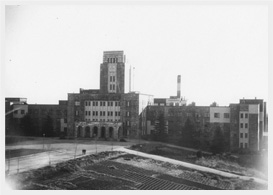
Photograph 2: Cherry trees had not yet
been planted in the early winter of 1949
Photo by Eizo Suyama
The cherry blossom trees in front of the Main Building of the Tokyo Institute of Technology (Tokyo Tech) on the Ookayama Campus have recently become famous. Sitting beneath the trees when they are in full bloom is like entering a world of mysterious profundity where it is possible to forget that one is in a major metropolis.
Those long-ago graduates would have a hard time believing just how large those cherry blossom trees have grown. For recent graduates, these cherry blossom trees in full bloom represent an important memory of campus life.
This article introduces the Institute's cherry blossom trees to the reader through three photographs [only two, Photographs 3 & 4, in this reprint].
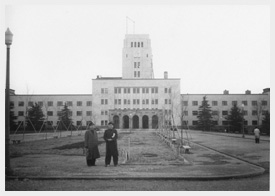
Photograph 3: Recently planted cherry trees
Photo by Eizo Suyama
The photograph at the top of this article [not available in this reprint] presents an image of the cherry trees taken in 1997 by Kenjiro Nakamura (Class of 1950, Department of Chemistry, School of Engineering). The photograph to the immediate left (Photograph 3) was taken in 1950 by Eizo Suyama. In this image it is possible to see the small cherry blossom trees which had been recently planted. We are grateful that Mr. Suyama kept this valuable photograph in such good condition.
. Any information published on this site will be valid in relation to Science Tokyo.


